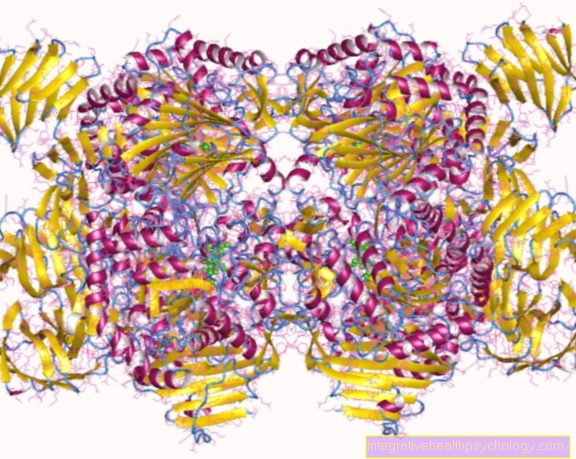Pearl Index
What is the Pearl Index
The so-called peal index is a value with which one tries to make different contraceptive methods comparable with one another with regard to their safety.It can be traced back to the American physician Raymond Pearl and describes the proportion of 100 women who use a certain method of contraception for a year and still become pregnant.
This means that a Pearl Index of 1 for a method of contraception means that out of 100 sexually active women who used this method of contraception for a year, one still got pregnant. Conversely, this also means that a contraceptive method is safer, the lower the Pearl Index.
Is the Pearl Index e.g. 20 out of 100 sexually active women will get 20 pregnant within one year.
The index can be calculated using the following formula:
Pearl index = number of pregnancies x 12 months x 100 / number of months of use x number of women.
With unprotected sexual intercourse, the Pearl Index is 82-87, depending on the age of the women.
At the time of menopause, the index drops to 0. For example, when using condoms, the index is 4-20.

The Pill's Pearl Index?
With the Pearl Index of the pill, a distinction must be made between which pill it is.
The index is 0.1-0.9 for the “normal” contraceptive pill, which contains estrogen +/- gestagens as an active ingredient and which is the most common and one of the safest contraceptive methods. That is, out of 1,000 sexually active women, 1-9 will become pregnant within one year.
The mini pill, on the other hand, only contains a progestin. The Pearl Index is therefore 0.5-3.
Read more about this under: Hormonal contraceptives
Mini pill
In contrast to the birth control pill, the mini pill contains only one progestin. The mucus in the cervix and in the uterus itself is thickened and changed in such a way that the sperm are restricted in their mobility and it is more difficult for the egg to implant.
The Pearl Index is slightly higher than that of the pill at 0.5-3.
Read more about this under: Hormonal contraceptives
Copper spiral
The copper coil is one of the intrauterine devices, it is inserted directly into the uterus. There are versions made of copper or with a copper-gold alloy.
Copper ions have an inhibitory effect on sperm, and a local sterile inflammatory reaction is triggered, which prevents the egg cell from implanting.
The mechanism of action is very effective, which results in a very low Pearl Index of 0.3-0.8.
That is, out of 1,000 sexually active women, 3-8 will become pregnant within one year.
Read more on the subject under: Spiral
Copper chain
The mechanism of action corresponds to that of the copper spiral. The advantage is an individual adjustment of the length by inserting or removing copper rings.
This is particularly positive for young patients who have not yet carried a pregnancy to term. Your uterus is much smaller and there may be no room for a traditional IUD.
Customization ensures that the entire length of the uterus is supplied with copper ions.
The pearl index is therefore slightly lower than that of the conventional copper spiral and is 0.1-0.5.
Read more on the subject under: The copper chain
Nuva ring
The Nuva ring is a plastic ring that is coated with hormones such as estrogen and progestin. It is inserted into the vagina once a month and left there for 3 weeks. The mechanism of action corresponds to that of the pill.
The hormones are released continuously. The lining of the uterus is changed in such a way that the egg cell cannot implant. If the Nuva ring is properly placed, it has a pearl index similar to the pill. It is 0.25-1.18.
The disadvantage of this method is the possible unnoticed slipping out or breaking of the ring, hence the larger range of the Pearl Index.
Read more about this under: Hormonal contraceptives
Copper ball
The copper ball is a relatively new method of contraception. The mechanism of action corresponds to that of the copper spiral and copper chain.
Copper ions have an inhibiting effect on sperm and prevent the egg cell from implanting through local sterile inflammatory reactions.
The advantage of this is that, in contrast to the copper chain, the copper ball does not have to be anchored in the uterus and can be easily removed. The pearl index corresponds to that of the copper spiral and is 0.3-0.8.
Diaphragm
The diaphragm is inserted into the vagina before intercourse so that it completely covers the cervix and prevents the sperm from escaping.
It is made of plastic, which must also be covered with a gel, which also has an inhibitory effect on sperm.
The diaphragm must be left in the vagina for up to 8 hours after intercourse.
When used properly, it has a pearl index of 1-8 with gel and up to 20 without gel.
This means that out of 100 women, 1-20 women become pregnant.
Read more about this under: Mechanical contraceptives and hormone-free contraceptives
Hormonal IUD
The hormone coil is inserted into the uterus like the copper coil. It releases progestogens in low doses.
The mobility of the sperm is reduced, as is the structure of the uterine lining, so that the egg cell cannot implant. In some cases, ovulation is completely suppressed by the hormonal influence.
The IUD is a very safe method of contraception with a Pearl Index of 0.16.
NFP
NFP is an abbreviation for natural family planning, it is also called the temperature method.
During the course of the menstrual cycle, the body temperature (basal temperature) fluctuates by up to one degree. The temperature increase is most pronounced around ovulation. The temperature must be increased by at least 0.2 degrees over the previous 6 days for at least 3 days.
The day of ovulation can then be determined retrospectively and the infertile days calculated. For this method, women have to deal intensively with their body. If used carefully, the method has a Pearl Index of 0.8-3.
Gynefix
Gynefix is the trade name of the currently used copper chain (see section copper chain).
The pearl index is 0.1-0.5.
Read more on the subject under: The copper chain and Gynefix
Contraceptive computer
The contraceptive computer is one of the natural contraception methods. By analyzing body temperature (basal temperature), hormone concentrations in the morning urine and the consistency of the cervical mucus, the computer calculates the time of ovulation and the following fertile days.
There are different types of computers that record different hormones.
The Pearl Index depends heavily on the individual computers. The contraceptive computer market is now large. However, many products have a very high index and should rather be used to determine the fertile days if you want to have children.
Read more about this under: Mechanical contraceptives and hormone-free contraceptives
Three-month injection
The three-month injection contains a progestin, which, as the name suggests, is injected into the muscle in the buttocks or upper arm every three months. The effect is the same as that of the pill.
Ovulation is not triggered by the changed hormone balance. The disadvantage is the relatively high dose of hormones.
The pearl index is 0.3-0.8.





























